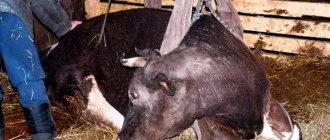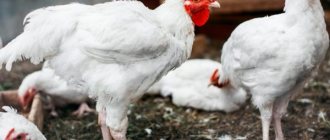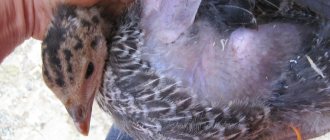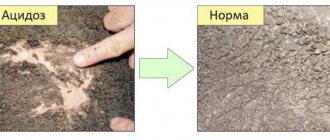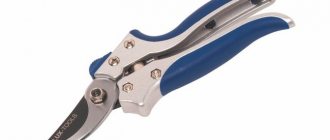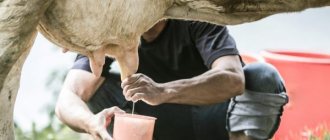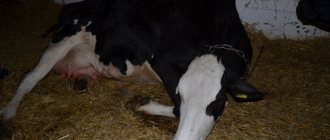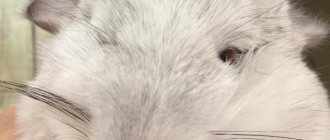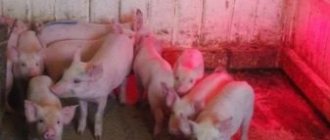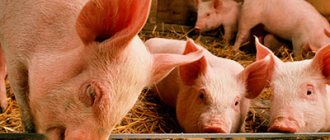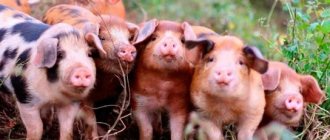If a piglet's hind legs fail, the reasons need to be identified, based on the fact that these can be symptoms of many diseases. In order not to confuse a banal lack of vitamins with a fatal pathology, one should approach the diagnosis with all seriousness. We will tell you why confusion happens and what to do in such situations. You will also learn about the psychological factors that influence animals and cause them to restrict their movement.
Symptom provocateurs
If a piglet does not stand on its hind legs, then this may be a symptom of completely different diseases. Unscrupulous care or poor nutrition also have an impact.
List of reasons why piglets fall on their feet:
- the existence of a deficiency of vitamins A, D and group B;
- lack of iron, copper, phosphorus;
- little calcium in the body;
- emotional and stressful conditions;
- flu;
- enzootic encephalomyelitis.
When any of the above factors are identified in a pig or piglet, measures must be taken immediately. All signs are quite serious and do not go away on their own. However, if the room is cold or even just a cool floor, then this can also cause limb failure.
Below we will discuss cases of abnormal condition of the piglet's limbs and methods of treatment.
Pigs fall on their feet: what to do? – AGRARY
The lower limbs of pigs can fail for other reasons (cold floor, stress, viral and bacterial diseases, worms), but when farmers or farmstead owners say the phrase “the pig fell on its feet” - that is, this is the main and often the only symptom - most often it goes We are talking specifically about metabolic disorders accompanied by a deficiency of phosphorus and calcium.
Calcium and phosphorus deficiency in pigs manifests itself as follows. At first you notice that the animal has difficulty getting up on its hind legs. Most often it is the hind legs, since they bear more of the load, but in some pigs the front legs are the first to fail.
The piglet shifts from foot to foot, often lies down, and tries to eat, leaning only on its forelimbs. In this case, appetite, as a rule, does not suffer much.
Only in extreme cases, when the animal has practically no strength to stand on its feet and get to the feeder, does it stop eating.
Pigs fall off their feet: treatment and prevention
So, we found out why pigs and piglets fall on their feet.
The reason lies in the disturbance of calcium-phosphorus metabolism, and it is not a fact that there is little calcium and phosphorus in the diet - without vitamins A and D they simply are not absorbed.
Therefore, all that needs to be done is to urgently provide the animal with calcium-phosphorus supplements and vitamins for their absorption, as well as metabolic stimulants for faster results.
The pig falls on its hind legs: what to do?
- Let him out for a walk.
Even in winter, with the exception of severely frosty days, you must let the cattle run around the yard. She will find something to eat: she will gnaw on a piece of red brick lying under the fence, she may be interested in bird droppings and other “garbage.” This is not to mention the benefits of exercise in principle, fresh air and sunlight as one of the sources of vitamin D, which is so important in winter. But this, of course, is a preventive measure. - Provide chalk, charcoal, red brick, eggshells and other organic and accessible sources of calcium.
These substances should be regularly present in the pigs' diet, especially if you feed not specialized feed, but homemade mash. - Include meat and bone, bone or fish meal in your daily diet - a rich source of calcium and phosphorus (in the form of calcium phosphate), as well as animal protein and fat.
Flour is introduced in an amount of up to 5% of the total pig diet not only to prevent disorders of calcium-phosphorus metabolism, but also to increase the meat productivity of animals (we wrote more about the use of meat and bone meal in animal husbandry here). - Fish oil has long been used to treat rickets and anemia, as it contains vitamins A, D, E, as well as iodine, bromine, sulfur, phosphorus and polyunsaturated fatty acids. For prevention, give from 5 to 20 ml per day per head, and if the piglet falls on its feet, be sure to increase the dose daily to 30-70 grams per head (depending on weight).
- Tricalcium phosphate is a light gray powder obtained from minerals and containing up to 18% phosphorus and up to 34% calcium. For prevention, this drug, sold in veterinary pharmacies, is given at the rate of 40-60 grams per head; if a problem appears, the dose is increased to 60-120 grams per head, depending on the weight of the animal.
By the way, tricalcium phosphate is so in demand in pig farming that when making compound feed with their own hands, farmers or simply homestead owners include this inorganic additive in the recipe. In general, tricalcium phosphate can be given all year round: you give it for 10 days, then a couple of weeks off, then again for 10 days, etc.But if the piglets fall on their feet, there is no need to take any breaks until the animal recovers completely.
- Vitamins A and D, necessary for the absorption of calcium and phosphorus.
They are either added to food or given as injections. If a pig falls on its feet, vitamins MUST be given AT THE SAME TIME with calcium-phosphorus preparations so that the minerals are absorbed. You can find many suitable products in pharmacies. - Metabolism stimulants. This may be Catozal, Phos-Bevit, Vitazal and other drugs. If the piglet falls on its feet, stimulants are administered for 5-10 days at a dose of 1-2 cc, for adult animals - up to 10 cc. For preventive purposes, stimulants are given two to three times a quarter.
We figured out why pigs fall on their feet, and we also learned how to help. Finally, I would like to note that metabolic disorders affect not only piglets: broilers, hens and chickens, calves and cows fall on their feet, laying hens peck at eggs. Therefore, walking in the sun and fresh air, introducing vitamins A and D into the feed along with calcium-phosphorus supplements (tricalcium phosphate, chalk, brick, bone meal) will be beneficial to all farm animals without exception. Naturally, the doses will differ from pigs.
Source: https://agrarii.com/svini-padajut-na-nogi-chto-delat/
Good conditions
First of all, you need to make sure that the pigs are in comfortable conditions and are not hungry or thirsty. If it is cold in the pigsty, then this is one of the reasons that animals may fall and not get back to their feet.
It is necessary to insulate the floor if it is really leaky. There should also be complete nutritional feeding for pigs and piglets, which is supplemented with micro- and macroelements and vitamins. Animals should not be under stress and should not be intimidated.
By observing these simple conditions, it is quite possible that the pigs will quickly return to normal, but if this does not happen, then the problem lies in more serious illnesses and cannot be done without the help of a veterinarian.
Diagnosis: influenza
In the case when piglets are sick with the flu, but there is a symptom of failure of the hind legs, this means that there is an acute form of the disease. But it is also characterized by other features. This is a high temperature (48 degrees), discharge from the heel, difficult breathing. The pig sits in one place and may have a cough or lethargy. This disease is characterized by bluish skin in the abdominal area two days after the first signs appear. In the article “All about swine flu” you will find details.
Without treatment, you won't be able to get rid of the flu. The veterinarian must examine the animal and prescribe medications. Usually these are antibiotics - oxytetracycline, chloramphenicol, streptomycin, amoxicillin. Injections of trivitamin, ascorbic acid, and B vitamins will help.
In order not to once again torment the pig or piglet with injections, vitamins can be added to food. In this case, the food should be dietary, and special preference should be given to liquid jelly-like porridges. The room where sick animals live must be dry and clean.
Dangerous enzootic encephalomyelitis
In another way, this name may sound like Teschen disease or porcine polio. The pathology is infectious in nature and affects the nervous system of animals. The result is paralysis and death.
In the early stages of porcine polio, loss of appetite in animals and an increase in body temperature up to 41 degrees can be detected. Individuals of different ages are affected, but more often piglets 2-6 months old. The disease has a latent period, which lasts up to 15 days, and sometimes up to 30.
After two days, the body temperature becomes normal, but other symptoms begin to appear. Since the nervous system is affected, the pig or piglet becomes restless and coordination of movements is impaired. Vomiting begins, and bloody and foamy discharge comes from the nose. Already 2 days after this, the animal does not get to its feet.
At the moment, no treatment has been developed. Pigs and piglets with such symptoms are sent to slaughter. It is imperative to disinfect the pigsty and all places where the sick individual was. Meat products can be eaten only after high-temperature processing in the form of canned food or boiled sausages.
Teschen's disease
Teschen's disease
Enzootic poliomyelitis occurs on small farms under unsatisfactory housing and feeding conditions. Nerve trunks are affected.
Clinical signs are detected in piglets from 1 to 3 months. Adult pigs do not get sick, but they carry the virus.
Teschen's disease occurs in a fulminant form, when the baby dies suddenly without pathological symptoms, as well as acute and chronic forms. In the latter case, the piglets' hind limbs fail and they move by crawling.
Be sure to read:
Erysipelas in pigs: description, forms and their symptoms, how to treat at home, serum, vaccine
Animals sometimes recover, but lameness and muscle atrophy do not disappear. Peers bully people with disabilities. Animals with clinical signs are slaughtered bloodlessly to prevent the spread of infection, and the farm is quarantined.
All pigs are vaccinated within two years.
At pig-breeding enterprises where livestock are vaccinated against plague and erysipelas, cross-immunity occurs against the causative agent of Teschen disease.
Iron deficiency
This disease is found mainly in piglets that are 3 to 6 weeks old. Iron deficiency anemia can be determined by the low content of hemoglobin and red blood cells in the blood.
Iron deficiency is accompanied by pallor of the skin and mucous membranes. At the same time, the babies do not suckle the sow well. The growth of young animals slows down, the eyelids swell, the bristles break, and wrinkles appear on the skin of the animals.
During anemia, the piglet does not stand up, as loss of motor activity, lethargy, and inactivity begin. If the animal is not cured within three weeks, it will die. When the body, in addition to iron, lacks copper, phosphorus, cobalt and B vitamins, death occurs earlier.
This issue must be dealt with by a veterinarian, but the farmer is able to provide the animals with adequate nutrition.
The piglet's hind legs gave out: causes, treatment
Raising pigs is a business that requires attention from the farmer. If his animals get sick, he will suffer losses. That is why it is important to pay attention in time to various symptoms indicating pathologies in the body.
For example, if a piglet's legs give out, you should immediately call a veterinarian for a diagnosis. This alarming symptom signals health problems and can accompany a variety of ailments.
The reasons for its occurrence will be discussed in this article.
Piglet won't get to his feet
Flu
Flu is a viral disease that spreads very quickly. The main outbreaks are observed in the cold season. The causative agent of the disease belongs to the genus Orthomyxoviruses.
When introduced into an animal’s body, viruses are found mainly in the mucous secretions of the bronchi, lungs and trachea, secretions from the nasal passages, and in small concentrations in the blood and urine of sick individuals.
If the disease is severe, the viruses penetrate the gallbladder and spleen.
The source of infection is virus-carrying individuals and sick pigs; the main route of spread of infection is airborne droplets. Symptoms of swine flu:
- Temperature rises to 41.5-42 degrees.
- Weakness.
- Depression, loss of appetite.
- Drainage of mucus from the nose, nosebleeds.
- Difficulty breathing, coughing, sneezing.
- Blueness of the skin in the abdominal area.
- Digestive disorders.
- The pig falls on its hind legs as joints and muscles are affected.
Reference. The prognosis for influenza in young animals is unfavorable - more than 30% of individuals die, since piglets are very susceptible to the disease. In sucklings, the infection almost always develops rapidly and affects the lungs.
Anemia
Iron deficiency in piglets causes anemia. The sow is not able to provide newborns with this element sufficiently, therefore, by the 10th day after birth, sucklings have a deficiency of iron in the blood. That is why, a few days after birth, piglets are injected with iron-containing drugs. If this is not done, symptoms of anemia will soon appear:
- Loss of appetite, reluctant sucking of mother's milk.
- Lethargy.
- Paleness of the skin and mucous membranes.
- Exhaustion.
- Swelling.
- Growth retardation.
- Due to muscle weakness, piglets cannot stand on their hind legs.
Attention! Anemia can be fatal. Such symptoms in pigs cannot be ignored.
Poliomyelitis (Teschen disease)
This disease is caused by an RNA virus classified as the first serotype of enteroviruses; it affects only pigs. When infected, the prognosis is unfavorable; almost all individuals die from complete paralysis.
Symptoms:
- In the first two days, no manifestations of the disease are observed, with the exception of loss of appetite, lethargy and an increase in temperature to 41.5 degrees.
- Subsequently, the temperature returns to normal.
- If the brain is affected, pigs behave excitedly, move involuntarily, breathe heavily, vomiting, teeth grinding, and hoarseness occur.
- When the spinal cord is damaged, the symptoms are different - coordination of movements is impaired, the animal falls on its feet, constantly lies, and sometimes makes characteristic swimming movements. Soon complete paralysis sets in.
Reference. Before death, there is a strong drop in temperature down to 35 degrees.
Lack of vitamins
With various vitamin deficiencies, pigs also often do not lose the ability to stand on their feet. Let's consider the most common problems associated with a lack of vitamins, accompanied by this symptom.
- Lack of vitamin D. This type of vitamin deficiency causes the disease rickets, in which the bones of animals gradually become deformed. As a result, the pigs fall to their feet and hardly get up.
- Lack of vitamins A, E and selenium causes white muscle disease. It is characterized by symptoms - muscle weakness, unsteady gait, sitting dog posture, shoulder blades protruding above the vertebrae, convulsions.
- A lack of B vitamins is accompanied by disorders of the nervous system and often causes paralysis. Among other things, such vitamin deficiency is indicated by increased excitability, stunted growth, exhaustion, and hair loss.
Treatment
If a pig cannot stand, it requires urgent treatment. There is no single scheme for it, since leg failure is not a disease, but only a symptom of many ailments. To help the animal, you need to find out the cause of this pathology.
If a pig gets sick with the flu, it is immediately isolated, provided with rest, and provided with dietary nutrition and plenty of fluids. For lung damage, sulfonamide drugs and cephalosporin antibiotics are used.
When the cause of leg failure in a pig is anemia, it is necessary to compensate for the lack of iron in the body. Iron supplements help with this.
Poliomyelitis or Teschen's disease, unfortunately, has no cure . It is better to immediately send a sick individual to slaughter; you should not wait for it to die from paralysis. The room is disinfected to prevent the spread of a dangerous virus.
If a pig suffers from vitamin deficiency, the farmer’s task is to compensate for the lack of vitamins and microelements in its body. For this purpose, special preparations and vitamin complexes are used. It is equally important to diversify the animal’s diet, increase the supply of food and feed that contain a large amount of missing substances.
For stress, treatment is carried out symptomatically. The main attention is paid to organizing normal living conditions and adequate nutrition. In order to increase immunity, pigs are given adaptogens, for example, Eleutherococcus.
Drugs
To treat pigs whose hind legs have failed, various drugs are used, depending on the diagnosis:
- Antibiotics.
- Vitamins.
- Immunoglobulins, adaptogens.
- Anticonvulsants.
Let us consider specifically which drugs belong to each of the listed groups.
Antibiotics help kill the bacterial infection. In veterinary medicine, drugs of the penicillin and cephalosporin series are widely used - Amoxisan, Sulfetrisan, Ceftiosan, Enrostin, Bicillin, Streptomycin.
When legs fail as a result of vitamin deficiency, vitamin supplements are used. The drug Tetravit contains vitamins A, E, D3 and F. It can be used for rickets, as well as white muscle disease, when the pig does not stand up. Multivit is another injection drug that contains a whole complex of vitamins. Suiferrovit is an iron-containing drug.
Weakened piglets need to increase their body's resistance so that they recover faster. The drug Trobig Life Start contains immunoglobulins, vitamins and probiotics.
Anticonvulsant medications are used to increase muscle tone. These include Gluferal, Hexamidine, Difenin.
Prevention
Preventative measures will help avoid leg failure in piglets. These include:
- Providing pigs with adequate nutrition, including vitamin supplements.
- animals in good conditions, in warm and dry rooms.
- Timely feeding of colostrum to newborns.
- To avoid infection of young animals with polio or influenza, avoid walking and grazing together with adults who may be carriers of the virus.
Failure of a piglet's hind legs should alert the farmer. This symptom is often associated with dangerous diseases that affect the central nervous system, vitamin deficiencies and infectious diseases. In each case, you need the help of a veterinarian who will make a diagnosis and prescribe treatment.
Source: https://FermHelp.ru/chto-delat-esli-porosenok-ne-vstaet-na-nogi-i-chem-ego-lechit/
Treatment of anemia
Anemia is treated with injections. Iron-containing drugs are administered intramuscularly. The following options are available to choose from: ferroglucin, ferrodex, suiferrovit, imferon, myofer, ursoferran. Two ml per day is enough.
The first injection is usually given to piglets on the 4th day of life. After two weeks, the injection is repeated. Usually the femoral part or the behind-the-ear area in the cervical area is pierced.
There are also iron preparations “Microanemin” and “Glycerophosphate”. They can be added to food throughout the week, but from the moment the piglet is born it is 5 days. Dosage – 1g/day every other day.
If the pig is deficient in other minerals, then their salts are added to the food. Another option for treating anemia in these animals is treating the sow's nipples with a 1% solution of iron sulfate.
Need for calcium
Calcium is the key to a strong skeleton, healthy muscle mass and good blood clotting in pigs. In addition, it helps the body absorb iron and improves immunity.
Piglets that have been weaned from the sow are the most vulnerable, as are adults. In the latter, this is manifested by bone fragility and the development of osteoporosis. Babies with calcium deficiency are susceptible to rickets and curvature of the limbs.
Symptoms indicating a lack of this element are poor appetite, inactivity, weight loss. The pig's legs also fail, causing falls and difficulty getting up. With positive dynamics of the development of the disease, bending of the limbs, throwing back of the head and convulsions occur.
If a piglet falls due to a lack of calcium, then it is injected intramuscularly with drugs that contain this element, as well as vitamin D. The food is made more balanced, with the addition of feed chalk, bone meal, and fish oil. Milk and yeast will also not be superfluous. Among medications, preference is given to tricalcium phosphate, calcium glycerophosphate and vitamin supplements, which are fed to pigs.
Sources of vitamin D are drugs such as Trivitamin and Tetravit. They are injected into the pig intramuscularly or behind the ear.
Why doesn't the piglet stand on its hind legs and how to treat them?
If a pig's legs fail, this indicates the presence of health problems that threaten the enterprise and bring losses instead of profit. In most situations, pathology occurs due to miscalculations of the livestock breeder and can be corrected independently, but in some cases it is impossible to do without seeking veterinary help.
This article explains to novice pig farmers why piglets fall on their feet, how to prevent pathology and how to treat it if it occurs.
Causes
Piglets fall on their hind legs and cannot get up for the following reasons:
- Unbalanced diet.
- Stress.
- Infectious diseases.
Fell to his feet
Unbalanced diet
Leg failure in a piglet most often occurs in the post-weaning period, but it is also observed while under the sow.
It turns out that milk contains little iron, and its reserves in the body are exhausted for the needs of hematopoiesis within three days. At this time, the cubs are unable to consume solid food, so iron supplements are delivered to the body parenterally.
Vietnamese breed piglets often sit on their feet, since the milk of sows contains very little iron.
Vietnamese pigs have little iron in their milk
The element is necessary, first of all, for the synthesis of the chromoprotein hemoglobin, which is part of red blood cells. If the red blood cell does not bring oxygen to the organs, they will not be able to function. The periphery that suffers the most is the legs.
After weaning, problems arise associated with a deficiency of biologically effective components, primarily calcium and vitamin D. Beginning pig breeders consider crushed cereal seeds, low in calcium, to be the best animal feed. In a severe situation, hypocalcic tetany develops. Why do pigs fall on their feet? Low blood calcium levels are accompanied by seizures.
But most often the problem arises as a result of a lack of vitamin D, without which bone tissue synthesis is impossible. Rickets develops, the limbs become bent, the ability to stand is lost, and the piglet lies down all the time.
Injections against anemia
Stress
Most often, the piglet experiences stress and may fall at the time of weaning, when the sow is removed from the pen and the children are left alone.
If you do the opposite and move the kids to a new place, the result will be even worse. Emotional stress is accompanied by stern stress.
Now the piglet is deprived of its mother's milk and is forced to consume solid feed. Falling on one's feet is preceded by diarrhea and refusal to eat.
Infectious diseases
Among the infectious diseases of piglets that cause leg failure are the following:
- Enzootic encephalomyelitis (Teschen disease). The virus affects young animals 2–6 months old. Hyperthermia, vomiting, diarrhea, rhinitis, accompanied by bloody discharge, are observed. The temperature drops, the pig does not stand up first on its hind legs, then on its front legs.
- Swine flu. The symptoms resemble a similar disease in humans.
- Pig erysipelas. Young animals 3–12 months of age suffer. One of the symptoms of a bacterial infection is inflammation of the joints and the pig falls on its hind legs.
- Plague. The most dangerous disease characterized by paralysis. An infected pig does not eat anything and does not stand on its feet.
Erysipelas
Treatment and prevention
The treatment concept is to eliminate the causes of the following deviations:
- Imbalanced diet.
- Stress.
- Infectious diseases.
Imbalanced diet
Prevention of anemia is achieved by parenteral administration of iron-containing drugs. The first injection should be made into the thigh muscles or the area behind the ear no later than the fourth day after birth. The second injection is given 7-10 days later.
In the interval between injections, piglets are recommended to be fed preparations containing iron and other microelements that prevent the occurrence of anemia. The best option is to use prestarter feed from five days of age.
The piglets get used to solid food, tolerate the weaning procedure more easily, and grow well.
What to do if rickets occurs? The problem is solved comprehensively. There are calciferol precursors in feed, but ultraviolet irradiation is required to convert them into the active substance. It is not always possible to organize walks in the sun, so it is useful to irradiate piglets with ultraviolet lamps. But this is not enough.
When preparing a diet, it is necessary to add calcium and vitamin D to the feed mixture. The best option is to use factory-made feed or use BVMK. The additive is mixed with the grain mixture in a ratio of 1–4/1–5. In some cases, injections of Trivitamin or other drugs for parenteral administration are practiced.
Sometimes falling on one's feet occurs when an unskilled pig farmer tries to prevent it. He adds chalk purchased at the market, intended for whitewashing, containing harmful components, to the mash, and the piglets fall on their feet.
Stress
Treatment with anti-stress drugs does not always lead to the desired effect. The greatest damage is caused by the psychological stress that occurs during weaning, as well as the transition from liquid feeding to solid food. Prevention is the use of early complementary feeding from the 5th–7th day of life. If necessary, dietary feed for piglets is used.
Medicines for piglets
To treat diseases in piglets that cause falling on their feet, the following drugs are used:
- Iron-containing.
- Sources of vitamin D.
- Calcium-containing substances.
- Antibiotics.
- Anti-stress.
Iron containing
The following injectable drugs are in demand:
- Ferroglukin.
- Ferrodex.
- Suiferrovit.
- Imperon.
- Myofer.
Tricalcium phosphate
Pig farmers prefer to give Microanemin or Iron Glycerophosphate internally. The optimal solution is to use prestarter feed or Premix P 51–1 for sucklings and weanlings.
Sources of vitamin D
The following preparations are popular among fat-soluble vitamins:
- Trivitamin (Trivit, Triovit).
- Tetravit.
Medicines are administered intramuscularly or behind the ear. Oral administration of these drugs, as well as fish oil recommended by some pig farmers, is associated with unproductive labor costs. The optimal solution is to use a premix.
Calcium-containing substances
It is preferable to feed Tricalcium Phosphate to pups, because traditional grain feeds are poor in calcium, and phosphorus is in a poorly digestible phytic form. You can use chalk, but only feed chalk.
Antibiotics
Long-acting antibiotics are in demand. Amoxicillin (penicillin group) is used once. Nitox (Oxytetracycline) has proven itself well.
Nitox
Anti-stress
Feed products are in demand - dietary feed, BVMK, premixes in combination with proper housing conditions - optimal temperature, air speed, regular cleaning of the pen.
Raising a piglet is a technological process, the violation of which leads to diseases, low growth rates, and increased production costs. You should not overestimate your knowledge in the field of feeding and keeping pigs and save on special feed. At weaning, the piglets must remain in the pen while the sow is moved to another location.
Source: https://fermers.ru/veterinariya/svinya/otkaz-nog
About vitamins
Vitamins must be in abundance, otherwise their deficiency causes considerable health problems.
A pig that lacks vitamin A may suffer from frequent conjunctivitis. Vitamin D can protect against rickets. With a lack of vitamin E, changes in muscle tissue occur in piglets. Animals are unable to stand; they sit or lie down.
B vitamins play an important role. You can give Thiamine injections (B, B1) - 3 ml in the morning. The course lasts 10 days. “Cyanocobolamin” (B12) is added to it - 3 ml. After two days, a double injection of Tetravit (F, E, D3, A) is given - 3 ml.
The food of piglets and pigs should be varied. It includes fresh herbs, vegetables, bone meal, fish oil. Dietary supplements also help maintain vitamin and mineral balance in the body. All individuals should not be deprived of walks in the sun.
